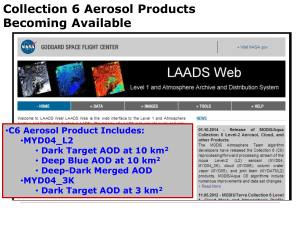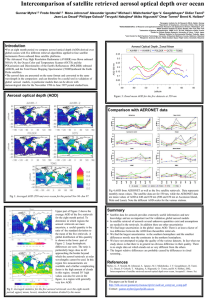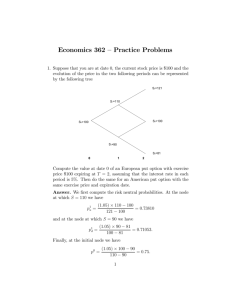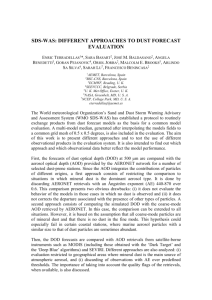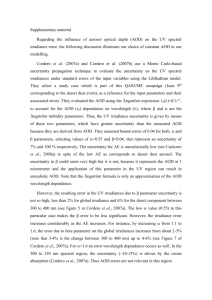SPATIO-TEMPORAL CHARACTERIZATION OF AEROSOLS THROUGH ACTIVE USE
advertisement
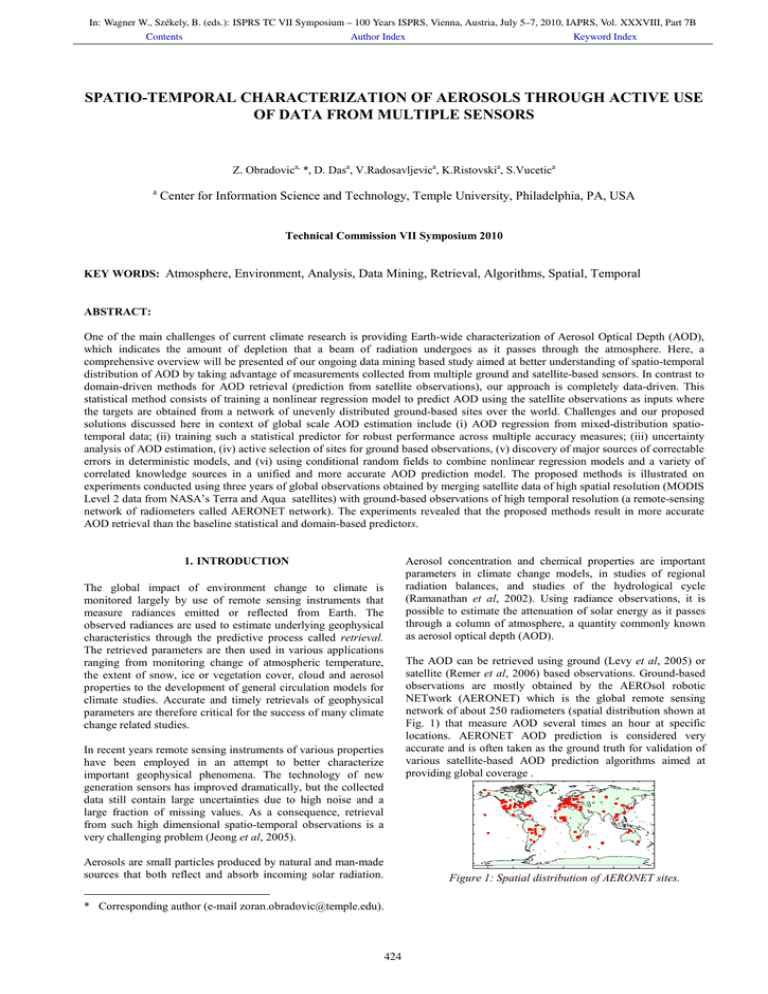
In: Wagner W., Székely, B. (eds.): ISPRS TC VII Symposium – 100 Years ISPRS, Vienna, Austria, July 5–7, 2010, IAPRS, Vol. XXXVIII, Part 7B
Contents
Author Index
Keyword Index
SPATIO-TEMPORAL CHARACTERIZATION OF AEROSOLS THROUGH ACTIVE USE
OF DATA FROM MULTIPLE SENSORS
Z. Obradovica, *, D. Dasa, V.Radosavljevica, K.Ristovskia, S.Vucetica
a
Center for Information Science and Technology, Temple University, Philadelphia, PA, USA
Technical Commission VII Symposium 2010
KEY WORDS: Atmosphere, Environment, Analysis, Data Mining, Retrieval, Algorithms, Spatial, Temporal
ABSTRACT:
One of the main challenges of current climate research is providing Earth-wide characterization of Aerosol Optical Depth (AOD),
which indicates the amount of depletion that a beam of radiation undergoes as it passes through the atmosphere. Here, a
comprehensive overview will be presented of our ongoing data mining based study aimed at better understanding of spatio-temporal
distribution of AOD by taking advantage of measurements collected from multiple ground and satellite-based sensors. In contrast to
domain-driven methods for AOD retrieval (prediction from satellite observations), our approach is completely data-driven. This
statistical method consists of training a nonlinear regression model to predict AOD using the satellite observations as inputs where
the targets are obtained from a network of unevenly distributed ground-based sites over the world. Challenges and our proposed
solutions discussed here in context of global scale AOD estimation include (i) AOD regression from mixed-distribution spatiotemporal data; (ii) training such a statistical predictor for robust performance across multiple accuracy measures; (iii) uncertainty
analysis of AOD estimation, (iv) active selection of sites for ground based observations, (v) discovery of major sources of correctable
errors in deterministic models, and (vi) using conditional random fields to combine nonlinear regression models and a variety of
correlated knowledge sources in a unified and more accurate AOD prediction model. The proposed methods is illustrated on
experiments conducted using three years of global observations obtained by merging satellite data of high spatial resolution (MODIS
Level 2 data from NASA’s Terra and Aqua satellites) with ground-based observations of high temporal resolution (a remote-sensing
network of radiometers called AERONET network). The experiments revealed that the proposed methods result in more accurate
AOD retrieval than the baseline statistical and domain-based predictors.
Aerosol concentration and chemical properties are important
parameters in climate change models, in studies of regional
radiation balances, and studies of the hydrological cycle
(Ramanathan et al, 2002). Using radiance observations, it is
possible to estimate the attenuation of solar energy as it passes
through a column of atmosphere, a quantity commonly known
as aerosol optical depth (AOD).
1. INTRODUCTION
The global impact of environment change to climate is
monitored largely by use of remote sensing instruments that
measure radiances emitted or reflected from Earth. The
observed radiances are used to estimate underlying geophysical
characteristics through the predictive process called retrieval.
The retrieved parameters are then used in various applications
ranging from monitoring change of atmospheric temperature,
the extent of snow, ice or vegetation cover, cloud and aerosol
properties to the development of general circulation models for
climate studies. Accurate and timely retrievals of geophysical
parameters are therefore critical for the success of many climate
change related studies.
The AOD can be retrieved using ground (Levy et al, 2005) or
satellite (Remer et al, 2006) based observations. Ground-based
observations are mostly obtained by the AEROsol robotic
NETwork (AERONET) which is the global remote sensing
network of about 250 radiometers (spatial distribution shown at
Fig. 1) that measure AOD several times an hour at specific
locations. AERONET AOD prediction is considered very
accurate and is often taken as the ground truth for validation of
various satellite-based AOD prediction algorithms aimed at
providing global coverage .
In recent years remote sensing instruments of various properties
have been employed in an attempt to better characterize
important geophysical phenomena. The technology of new
generation sensors has improved dramatically, but the collected
data still contain large uncertainties due to high noise and a
large fraction of missing values. As a consequence, retrieval
from such high dimensional spatio-temporal observations is a
very challenging problem (Jeong et al, 2005).
Aerosols are small particles produced by natural and man-made
sources that both reflect and absorb incoming solar radiation.
Figure 1: Spatial distribution of AERONET sites.
* Corresponding author (e-mail zoran.obradovic@temple.edu).
424
In: Wagner W., Székely, B. (eds.): ISPRS TC VII Symposium – 100 Years ISPRS, Vienna, Austria, July 5–7, 2010, IAPRS, Vol. XXXVIII, Part 7B
Contents
Author Index
Keyword Index
difficulties in capturing complex radiance-aerosol relationships
in all realistic scenarios; and (4) significant retrieval
inaccuracies that are due both to the instrument limitations and
imperfections in the retrieval algorithms.
The main limitation of ground based observations is their low
spatial coverage. Therefore, satellite-based aerosol related
observations from several new instruments of high spatial
coverage are also considered. The MODerate resolution
Imaging Spectrometer (MODIS), aboard NASA’s Terra and
Aqua satellites launched in 1999 and 2002 with a single camera
observes reflected solar radiation from the Earth over a large
spectral range in 7 bands. It has a repeating cycle of 16 days and
high spatial resolution with almost daily coverage of the entire
planet. In comparison, MISR, also aboard Terra satellite, is a
nine camera instrument with four bands per camera that
provides global coverage every 9 days. MISR collects raw data
at 1.1 km resolution, but retrieves aerosol properties at 17.6 km
resolution for twenty-four postulated aerosol types. MODIS on
the other hand collects data at 1km resolution and its retrievals
are provided at 10km resolution.
Our team has demonstrated that more accurate retrieval is
achievable by a completely data-driven approach using spatiotemporally collocated satellite and ground based observations as
shown at Fig 3 (Han et al, 2005a; 2005b; 2006a; 2006b; Das et
al, 2008; Obradovic et al, 2006; Xu et al, 2005; Zhuang et al
2008). This statistical method consists of training a nonlinear
regression model using the satellite observations as inputs and
ground based AOD measurements as target. Some of our recent
related activities and findings are discussed in this article (Das
et al, 2009; Radosavljevic et al 2008; 2009; 2010a; 2010b;
Ristovski et al, 2009; Vucetic et al, 2008).
Designing accurate AOD predictors from satellite observations
is a very challenging task due to various problems including
reflectance superposition from multiple sources (effects of
clouds and surface reflectance are illustrated at Fig. 2).
Therefore, satellite based retrievals are less accurate than
ground based retrievals. However, they provide high spatial
coverage and so are very important for climate studies.
Figure 3: Spatio-temporal collocation of MODIS and
AERONET data. A is an AERONET site with AOD retrieved
within a short time before and after the satellite overpass
(circle dots). The square regions are MODIS observations in a
proximity of AERONET site A at the satellite overpass time.
2. METHODOLOGY
Figure 2: Physics of satellite-based retrieval.
The overall objective of our study is to facilitate aerosol
retrieval algorithms development, application and modification
by developing data mining methodology that utilizes satellite
data together with ground-based measurements. Our specific
aims are do determine if data mining can
•
provide accurate statistical AOD retrievals;
•
help discovering the major sources of correctable
retrieval errors of deterministic retrievals;
•
improve understanding spatio-temporal properties of
deterministic retrievals.
An overview of our recently proposed approaches towards
achieving these aims is provided in this section.
Most operational aerosol retrieval algorithms are constructed as
inverse operators of high-dimensional non-linear functions
derived from forward-simulation models according to the
domain knowledge of aerosol physical properties [35,36,67,68].
For example, MISR uses 24 compositional aerosol models in
the Aerosol Climatology Product. These aerosol models, such
as mineral dust, biomass burning particles and urban soot, are
considered to be representative of the types found over the
globe. They are mixtures of individual component aerosols,
where each component is defined by a size distribution, particle
shape, spectral index of refraction and vertical distribution
within the atmosphere. Up to three components can comprise an
aerosol mixture, and the fractional optical depths of the
components making up a given mixture are pre-specified. For
each component aerosol, the corresponding radiative properties
are computed using wavelength, illumination, and view
geometry information. The results are recorded in a look-up
table. By using a modified linear mixing theory, the radiative
properties of a mixture are calculated during the retrieval
process. These simulated data are then compared to actual
observations for the appropriate scene type (land or ocean).
According to a set of goodness-of-fit criteria based on the
domain knowledge, the matched aerosol model in the look-up
table is used for AOD computation.
2.1 Spatio-Temporal Data Partitioning for AOD Retrieval
In principle, AOD retrievals of high spatial resolution can be
obtained from satellite observations by training a regression
model on a dataset that consists of the satellite observations as
inputs and more accurate ground based AOD measurements as
output. However, challenges of such supervised learning on
aerosol data collected over space and time include existence of
different relationships among observations and AOD over
various spatio-temporal regions. In such situations an
appropriate spatial-temporal data partitioning followed by
building specialized predictors could often achieve higher
overall prediction accuracy than when learning a single
predictor on all the data. In practice, such partitions are
typically decided based on prior knowledge.
Drawbacks of deterministic retrieval methods include (1) high
computational cost due to inversion of nonlinear forward
models; (2) slow development due to manual construction of
the postulated physical models; (3) suboptimality due to
As an alternative to the domain-based partitioning, we have
proposed a method that automatically discovers a soft spatio-
425
In: Wagner W., Székely, B. (eds.): ISPRS TC VII Symposium – 100 Years ISPRS, Vienna, Austria, July 5–7, 2010, IAPRS, Vol. XXXVIII, Part 7B
Contents
Author Index
Keyword Index
temporal partitioning of Earth AOD through the competition of
gating regression models (Radosavljevic et al, 2008). To
address the spatio-temporal dependence the algorithm takes
information about location and time of data points as inputs for
gating function and performs competition among specialized
predictors for each point in the dataset. It starts by randomly
dividing the dataset into two disjoint subsets. A specialized
predictor is then trained on each subset. Iteratively data are
reassigned with some weight to each predictor. Weight is
determined based on gating output and accuracy of regression
models. Predictors and gating network are then retrained taking
into account new assignment.
attributes. We used a standard Mean Squared Error (MSE)
criterion to train this network. The second approach assumed
heteroscedastic noise and defined the conditional target
distribution. The uncertainty estimation neural network is
obtained by maximizing the corresponding log-likelihood. The
second method assumes that the conditional mean is exactly
estimated by the bootstrap committee. Since this is only an
estimate, in the third approach we also considered the model
uncertainty. In this approach error occurs due to both
uncertainty in the model and noise in target.
2.2 AOD Retrieval across Multiple Accuracy Measures
Ground based AOD stations are often located without a
rigorous statistical design. Decisions are typically based on
practical circumstances (e.g. overrepresentation in urban
regions and industrialized nations) and according to domain
experts’ assumptions about the importance of specific sites.
Given these circumstances, our aim was
to evaluate
performance of the current design of AERONET sensor
network and to apply data mining techniques to assist in future
modifications of the sensor network.
2.4 Selection of Sites for Ground Based Observations
Well known accuracy measures such as Mean Squared Error
(MSE) are often not informative enough because (1) retrieval
error increases with AOD, (2) distribution of AOD is skewed
towards small values, and (3) there are many outliers. Instead,
domain scientists use an array of accuracy measures to gain
better insight into the retrieval accuracy. For example, the Mean
Squared Relative Error (MSRE) makes larger absolute errors
more tolerable when predicting large AOD than when
predicting small AOD. Ideally, one would like to have a
retrieval algorithm that provides good accuracy with respect to
these alternative accuracy measures.
In (Radosavljevic et al, 2009) we assumed that there is a
pending budget cut for maintenance of the existing AERONET
sites. The objective was to remove a fraction of the AERONET
sites while making sure that the utility of the remaining sites is
as high as possible. We made a simplifying assumption that
operational costs for each AERONET site around the globe are
equal. Common to most selection techniques originating from
the spatial statistics is a tendency to overlook the time
dimension of data collected by the sensor network. Therefore,
we considered series of observations and proposed to optimize
AERONET sensor selection based on the concept of retrieval
accuracy. Each AERONET site provides a time series which we
used for training a regression model to retrieve future AOD.
Sites that can be removed are those whose observations are best
predicted by the model built on data from the remaining sites.
To address this issue we considered training of neural networks
that minimize MSRE instead of MSE. In order to construct a
predictor that is also accurate with respect to MSE and several
other accuracy measures, we proposed an approach that builds
an ensemble of neural networks, each trained with slightly
different MSRE measure (Radosavljevic et al, 2010a). The
outputs of the ensemble are then used as inputs to a meta-level
neural network that produces the actual AOD predictions.
2.3 Uncertainty Analysis of AOD Retrieval
In this task our objective was to explore if neural networks can
provide estimates about retrieval uncertainty in addition to
providing accurate retrievals. Uncertainty estimation for the
confidence of retrieval requires modeling of the whole
conditional distribution of the target variable. A standard
approaches for neural network uncertainty estimation assume
constant noise variance. However, this assumption is not valid
for AOD retrieval where noise is heteroscedastic (variance of
noise is input-dependent). This is why we explored the
Bayesian approach for uncertainty estimation, based on the
previous work by Bishop and Quazaz. We also considered
alternatives based on the bootstrap technique that are more
tractable for large data sets.
In (Das et al, 2009) our objective was to determine appropriate
locations for the next set of ground-based data collection sites
as to maximize accuracy of AOD prediction. Ideally, a new site
should capture the most significant unseen aerosol patterns and
should be least correlated with the previously observed patterns.
We proposed achieving this aim by selecting the locations on
which the existing prediction model is most uncertain. Several
criteria were considered for site selection, including uncertainty,
spatial diversity, temporal similarity, and their combination.
Spatial diversity selects sites that are farthest away from the
existing sites. The traditional approach in active learning is to
label the most uncertain data points. In our application, instead
of selecting an individual data point, we select a site. To address
this, we defined uncertainty of a site as the average uncertainty
over all its observations. For this purpose, we trained a number
of neural networks on data obtained from the existing
AERONET sites using the bootstrap method. Then we used
these neural networks to predict the value of AOD at all satellite
observations over potential AERONET sites. We measured the
variance among the network predictions and considered this
variance as the uncertainty of prediction at the individual datapoints. The selected sites are those with the highest measured
uncertainty. One drawback of the site uncertainty selection is
that a global measure like average uncertainty might fail to
compare the similarity in temporal variation of the uncertainty
among sites. Each of the potential sites can be regarded as a
A neural network-based regression assumes that target y is
related to input vector x by stochastic and deterministic
components. The stochastic component is a random variation of
target values around its mean caused by heteroscedastic noise
with zero-mean Gaussian distribution and input-dependent
variance. The deterministic component determines a functional
relationship between attributes and prediction. Our goal was to
estimate both the stochastic and deterministic component as
good as possible.
In (Ristovski et al, 2009) we have evaluated three approaches
for estimating the stochastic component. The first was based on
training a neural network to predict squared error from
426
In: Wagner W., Székely, B. (eds.): ISPRS TC VII Symposium – 100 Years ISPRS, Vienna, Austria, July 5–7, 2010, IAPRS, Vol. XXXVIII, Part 7B
Contents
Author Index
time-series of uncertainty values over a year. It has been
observed that the shapes of uncertainty time-series closely
match with that of AOD time-series because the uncertainty
values are highly correlated with AOD. So, we used uncertainty
estimates as a proxy for the actual AOD labels that cannot be
observed over candidate sites. A potential drawback of the
previous three site selection algorithms is that selection by one
metric is not guaranteed to be the same as that selected by
another metric. Therefore, we modified these algorithms to
combine uncertainty, spatial and temporal correlation criteria in
a single measure. Our objective was to evaluate which approach
is the most appropriate for AERONET site selection
Keyword Index
3. RESULTS
3.1 Spatio-Temporal Data Partitioning for AOD Retrieval
Following methodology summarize in Section 2.1 we
performed large scale experiment using 2 years of data from
more than 200 ground based AERONET sites located at six
continents spatio-temporally collected with data from MODIS
instrument aboard NASA’s Earth observing Terra and Aqua
satellites. The obtained soft partitioning results (illustrated at
Fig. 4) were compared to the data partitioning used in the
MODIS operational algorithm that divides the world into three
spatial-temporal regions based on domain knowledge. The
experiments showed that the new soft partitioning of Earth
results in significant AOD retrieval accuracy improvements
(Radosavljevic et al, 2008).
2.5 Discovering Correctable AOD Retrieval Error
We analyzed performance of the operational MODIS aerosol
retrieval algorithm. Overall, the main sources of MODIS
aerosol retrieval errors are the separation of surface and
atmospheric components of the observed radiances, the
inaccuracies in the forward-simulation model, and inversion
errors. Some sources of retrieval uncertainties, such as bright
surfaces or cloud-contaminated scenes, are due to the
limitations of the MODIS instrument and cannot be corrected,
while others, such as imperfections in the retrieval algorithm,
are correctable. Aerosol scientists’ major goal is to understand
the primary sources of correctable retrieval errors and to use
such knowledge to improve the retrieval algorithms. The goal of
this study was to explore if data mining could facilitate this
process.
01-Jan-2006
90
1
0.9
60
0.8
0.7
30
0.6
0.5
0
0.4
0.3
-30
0.2
0.1
-60
-180
-120
-60
0
60
120
180
0
01-Jul-2006
90
1
0.9
0.8
60
0.7
Our approach consisted of the three main components: 1) use
collocated AERONET and MODIS data to train neural
networks for the retrieval of AOD; 2) compare the accuracy of
neural networks and the MODIS operational algorithm, and 3)
understand the present conditions in instances when the neural
network is more accurate than MODIS retrievals. A neural
network trained in the first step is a completely data-driven
retrieval algorithm, distinct from the model-driven MODIS
operational algorithm. The drawback of neural network retrieval
is that its high accuracy is not guaranteed for the conditions
unlike those at the AERONET sites. As such, neural networks
are not a completely viable alternative to model-driven retrieval
algorithms. However, if neural networks can achieve higher
retrieval accuracy over the AERONET locations, then it is clear
that the accuracy of a model-driven algorithm can be further
improved.
0.6
30
0.5
0.4
0
0.3
0.2
-30
0.1
-60
-180
-120
-60
0
60
120
180
0
Figure 4: Spatio-temporal partitioning of Earth discovered by
competition of two AOD prediction models. Pixel color
corresponds to weight w assigned to one AOD predictor in a
mixture. The other predictor has weight 1-w. Top panel: winter
partitions, Bottom panel: summer partitions.
3.2 AOD Retrieval across Multiple Accuracy Measures
Neural networks from the ensemble described in Section 2.2
were trained using collocated data points whose attributes were
derived from MODIS instrument satellite observations and
whose target AOD variable was obtained from the ground-based
AERONET instruments. Instead of relying on MSE
minimization criterion for neural network training, we used the
relative error REL, which can be considered as generalization of
MSE.
2.6 Unifying Multiple Retrievals by Structural Regression
The aerosol data are characterized by strong spatial and
temporal dependencies. To exploit these dependencies we have
recently developed Continuous Conditional Random Fields
(CRF) for AOD retrieval that are able to exploit by defining
interactions among outputs using feature functions
(Radosavljevic et al, 2010b). The use of features to define the
CRF models allowed us also to include arbitrary properties of
input-output pairs into the compatibility measure. Our CRF
probabilistic model for structured regression uses multiple nonstructured predictors as its features. Features were constructed
as squared prediction errors of deterministic and statistical
models and we showed that this results in multivariate Gaussian
conditional P(y|x) distribution. Consequently, in the proposed
approach learning is a convex optimization problem with a
global solution for a set of parameters and inference is
conveniently conducted through matrix computation.
We observed that REL criterion allowed us to achieve increased
accuracy over certain ranges of AOD values. To provide a
predictor that is accurate over the whole range of AOD values
for each of the 5 commonly used accuracy measures, we
developed an ensemble of neural networks with adaptive cost
functions. Some networks in the ensemble were specialized in
predicting small AOD while others were specialized in
predicting large AOD. The experiments showed that the
proposed ensemble outperformed an ensemble that used
standard MSE optimization; it managed to achieve as high
MSE, R2 and CORR accuracies while it significantly improved
MSRE and FRAC accuracies. In addition, AOD prediction
accuracy of the proposed ensemble was compared to the
427
In: Wagner W., Székely, B. (eds.): ISPRS TC VII Symposium – 100 Years ISPRS, Vienna, Austria, July 5–7, 2010, IAPRS, Vol. XXXVIII, Part 7B
Contents
Author Index
Keyword Index
spanned the entire world, ranging from January of 2005 to
December of 2006. A committee of 20 neural networks was
used to estimate the model uncertainty, each having 10 hidden
nodes. Initial training set was created with 700 training points
from 10 randomly selected AERONET sites. We assumed that
the AOD values corresponding to the remaining training points
are unknown. Then we proceeded to select t = {1, 2, … 20}
sites in twenty independent experiments using the proposed site
selection algorithms. The R-squared accuracy was computed on
the test data before and after the selection of prospective sites.
Our results show that uncertainty-based site selection gives
significantly higher accuracy over random and spatial distancebased selection (especially when only a few sites are to be
selected) and marginally higher accuracy than temporal
distance-based method. Performance improves further if
correlation among the sites is taken into consideration. A
comparison between accuracies uncertainty-based and all three
other methods which selects site based on combination of
uncertainty, spatial and temporal distance shows that there is
some improvement in performance due to inclusion of spatial
and temporal correlation metrics over purely uncertainty-based
selection. Although the improvement in accuracy is small, it is
not negligible, keeping in mind the huge variability of AOD
over the entire earth.
recently developed operational MODIS Collection 005 retrieval
algorithm. Results obtained over the entire globe during the first
six months of year 2005 showed that the proposed ensemble of
neural networks was significantly more accurate for all the
considered accuracy measures (Radosavljevic et al, 2010a).
3.3 Uncertainty Analysis of AOD Retrieval
Three years of MODIS data collocated with 201 AERONET
sites over whole the globe have been used for uncertainty
analysis of AOD retrieval. The average negative log-predictive
density (NLPD) of the true targets was used as a measure of the
quality of uncertainty estimation. Committees of 30 neural
networks were trained on the subset of sites which have data in
both training and testing years. The obtained results allowed
analysis of uncertainty of AOD retrieval at a given site over
time and also uncertainty comparison at multiple sites. As an
example, we compared uncertainty of AOD retrieval at Beijing
site in China vs. Muana Loa site in Hawaii to conclude that
properties of aerosols are much more stable at Muana Loa than
in Beijing. By further investigation we found that this discovery
is consistent with domain experts’ expectations as this site
serves for calibration statistics of AERONET instruments.
Our analysis of seasonal uncertainty levels over three years also
revealed existence of different interesting patterns. For example,
we compared sites with the highest and the lowest average
uncertainty over the seasons. The highest uncertainty levels
occur in Asia over all seasons, in Africa during the winter and
fall, and in the central part of South America during the
summer. These levels reach extreme values in summer while for
other seasons are almost equal. On the other hand, the lowest
levels of uncertainty appear in North America and Europe
during winter, summer, and fall, and in South America during
the spring (Ristovski et al, 2009).
At the continent scale, we observed that different continents
favor different selection algorithms. For Europe, random
selection works quite well because a large number of unlabeled
sites are from Europe and therefore random selection favors
sites from Europe. In North America, despite the large number
of candidate sites, the random selection was not very successful.
The accuracies for North America generally followed the
accuracies obtained on overall test set. In South America and
Africa, spatial selection performed better than other methods.
Especially in South America, it was able to attain a significantly
higher accuracy (Das et al, 2009)
3.4 Selection of Sites for Ground Based Observations
3.5 Discovering Correctable AOD Retrieval Error
Data used in sites reduction experiments were distributed over
entire globe at 217 AERONET sites during years 2005 and
2006. We performed training on 2005 data and used 2006 data
for testing. We considered a scenario when current operational
AERONET sites have to be reduced by 33% or 66%. In all
experiments, we started from a set of 30 AERONET sites and
applied the proposed method and the two alternatives to identify
a subset of 20 or 10 AERONET sites to be retained. The two
alternatives included a random selection of sites as well as an
approach based on spatial distance among the sites was also
considered. Sites were selected such that their spatial coverage
was maximized. In our experiments, the proposed accuracybased selection achieved consistently better results than the
alternatives. Also, accuracy of the proposed site reduction
method did not change much even after removing 20 of the 30
AERONET sites. Interestingly, on average, the spatial selection
strategy performed slightly worse than the random selection
strategy. According to presented results we concluded that the
proposed accuracy-based sites reduction method is superior to
spatially-based
and
random
selection
alternatives
(Radosavljevic et al, 2009).
Our approach described in Section 2.5 was applied on 3,646
collocated MODIS and AERONET observations within the
continental United States. The results showed that neural
networks are more accurate than the operational MODIS
algorithm over the observed locations. A study of differences
between neural networks and the MODIS algorithm revealed
interesting findings. For example, NN are more accurate than
MODIS when the retrieval is contaminated by clouds, snow, or
water (i.e. NDVI <= 0). These and other discoveries have been
found to be mostly consistent with expert knowledge and
revealed some new insights into the MODIS algorithm
performance (Vucetic et al, 2008).
3.6 Unifying Multiple Retrievals by Structural Regression
Experiments were conducted on MODIS data at 50x50 km2
resolution collocated with observations at 217 AERONET sites
during years 2005 and 2006. In nested spatio-temporal 5-crossvalidation
experiments
we
determined
parameters
corresponding to the operational C005 and neural network
(NN) retrievals over five continents (Asia and Australia were
treated as a single region). In our experiments CRF achieved
significantly better accuracy than either NN or C005 alone.
Our extensive experiments on globally distributed data over 90
AERONET sites from the years 2005 and 2006 provide strong
evidence that sites selected using the algorithm proposed in
Section 2.5 improve the overall AOD prediction accuracy at a
faster rate than those selected randomly or based on spatial
diversity among sites (Das et al, 2009). The evaluation data
In follow-up experiments when using indicator functions for 5
continents (Asia and Australia were treated as one continent)
CRF achieved better accuracy than either NN or C005 alone
428
In: Wagner W., Székely, B. (eds.): ISPRS TC VII Symposium – 100 Years ISPRS, Vienna, Austria, July 5–7, 2010, IAPRS, Vol. XXXVIII, Part 7B
Contents
Author Index
Keyword Index
MODIS Aerosol Retrievals over Ocean and Land during
CLAMS, J. Atmos. Sci., vol. 62(4), pp. 974-992.
over almost all continents. Values of obtained parameters
suggest that we should trust NN more in the Eastern US, an area
well covered by AERONET sites where SR is expected to work
well, while in Africa, an area poorly covered by AERONET, we
should trust C005 more (Radosavljevic et al, 2010b).
Obradovic, Z, Han, B., Xu, Q., Li, Y., Braverman, A., Li, Z.
Vucetic, S. 2006. Data Mining Support for Aerosol Retrieval
and Analysis – Project Summary, NASA Data Mining
Workshop, Pasadena, CA.
4. CONCLUSION
The reported results provide strong evidence that accurate
statistical AOD retrieval is possible by problem partitioning
through competition of local spatio-temporal models
(Radosavljevic et al, 2008) and developing an ensemble
statistical model with components specialized for small and for
large AOD prediction (Radosavljevic et al, 2010a). It was also
found in our study how to analyze uncertainly of statistical
AOD retrievals (Ristovski et al, 2009) and how to use this tool
for optimized placement of ground-based observation sensors
(Das et al, 2009). A data mining analysis can also reveal the
conditions when deterministic AOD retrievals can be
significantly enhanced (Vucetic et al, 2008). Our work in
progress on structural regression by continuous conditional
random fields suggests that further major improvements of
retrieval accuracy can be achieved by unifying multi-source
retrievals (Radosavljevic et al, 2010b).
Radosavljevic, V., Vucetic, S., Obradovic, Z. 2010a. A Data
Mining Technique for Aerosol Retrieval Across Multiple
Accuracy Measures, IEEE Geoscience and Remote Sensing
Letters, vol. 7, no.2, pp. 411-415.
Radosavljevic, V., Obradovic, Z., Vucetic, S. 2010b.
Continuous Conditional Random Fields for Regression in
Remote Sensing, Proc. 19th European Conf. on Artificial
Intelligence, Lisbon, Portugal.
Radosavljevic, V., Vucetic, S., Obradovic, Z. 2009. Reduction
of Ground-Based Sensor Sites for Spatio-Temporal Analysis of
Aerosols, Proc. 3rd International Workshop on Knowledge
Discovery from Sensor Data at the 15th ACM SIGKDD Conf.
Knowledge Discovery and Data Mining, Paris, France.
Radosavljevic, V., Vucetic, S., Obradovic, Z. 2008. SpatioTemporal Partitioning for Improving Aerosol Prediction
Accuracy, Proc. Eight SIAM Int’l Conf. Data Mining, Atlanta,
GA.
References
Das, D., Obradovic, Z., Vucetic, S. 2009. Active Selection of
Sensor Sites in Remote Sensing Applications, Proc. IEEE Int’l
Conf. Data Mining, December, Miami, FL.
Ramanathan, V., Crutzen, P.J., Kiehl, J.T., Rosenfeld, D. 2002.
Atmosphere - Aerosols, climate, and the hydrological cycle,
Science, vol. 294, pp. 2119-2124.
Das, D., Radosavljevic, V., Vucetic, S., Obradovic, Z. 2008.
Reducing Need for Collocated Ground and Satellite based
Observations in Statistical Aerosol Optical Depth Estimation,
IEEE Int’l Geoscience and Remote Sensing Symposium,
Boston, MA.
Remer, L. A., Tanré, D. , Kaufman, Y. J., 2006. Algorithm for
Remote Sensing of Tropospheric Aerosol from MODIS for
Collection 005, http://modis-atmos.gsfc.nasa.gov/atbd02.pdf.
Han, B., Vucetic, S., Braverman, A., Obradovic, Z. 2006a. A
Statistical Complement to Deterministic Algorithms for
Retrieving Aerosol Optical Thickness from Radiance Data,
Engineering Applications of Artificial Intelligence, vol. 19, no.
7, pp. 787-795.
Ristovski, K., Vucetic, S., Obradovic, Z. 2009. Evaluation of a
Neural Networks based Approach for Aerosol Optical Depth
Retrieval and Uncertainty Estimation, Proc. Int’l Conf. on
Space Technology, Thessaloniki, Greece.
Han, B., Obradovic, Z, Li, Z., Vucetic, S., 2006b. Data Mining
Support for Improvement of MODIS Aerosol Retrievals, Proc.
IEEE Int’l Geoscience and Remote Sensing Symp., Denver, CO.
Vucetic, S., Han, B., Mi, W., Li. Z., Obradovic, Z. 2008. A
Data Mining Approach for the Validation of Aerosol Retrievals,
IEEE Geoscience and Remote Sensing Letters, vol. 5, no. 1, pp.
113-117.
Han, B., Vucetic, S., Braverman, A., Obradovic, Z. 2005a.
Integration of Deterministic and Statistical Algorithms for
Aerosol Retrieval, Proc. Int’l Conf. Novel Applications of
Neural Networks in Engineering, Lillie, France, pp. 85-92.
Xu, Q., Han, B., Li, Y., Braverman, A., Obradovic, Z., Vucetic,
S. 2005. Improving Aerosol Retrieval Performance by
Integrating AERONET, MISR, and MODIS Data Products,
Proc. IEEE 8th Int’l Conf. Information Fusion, B.11.3 pp. 1-8,
Philadelphia, PA.
Han, B., Vucetic, S., Braverman, A., Obradovic, Z. 2005b.
Construction of an Accurate Geospatial Predictor by Fusion of
Global and Local Models, Proc. IEEE 8th Int’l Conf.
Information Fusion, B.11.2 pp. 1-8, Philadelphia, PA.
Zhuang, W., Radosavljevic, Han, B., Obradovic, Z., Vucetic, S.
2008. Aerosol Optical Depth Prediction from Satellite
Observations by Multiple Instance Regression, Proc. Eight
SIAM Int’l Conf. Data Mining,, Atlanta, GA.
Jeong, M.-J., Li, Z., Chu, D. A., Tsay, S.-C. 2005. Quality and
Compatibility Analyses of Global Aerosol Products Derived
from the Advanced Very High Resolution Radiometer and
Moderate Resolution Imaging Spectroradiometer, J. Geophys.
Res., 110, D10S09.
Acknowledgement
This work was supported in part by the National Science
Foundation under Grant IIS-0612149.
Levy, R. C., Remer, L. A., Martins, L.V., Kaufman, Y.J., PlanaFattori A., Redemann, J., Wenny, B. 2005. Evaluation of the
429

